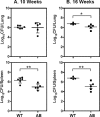Iron storage proteins are essential for the survival and pathogenesis of Mycobacterium tuberculosis in THP-1 macrophages and the guinea pig model of infection
- PMID: 22101841
- PMCID: PMC3264086
- DOI: 10.1128/JB.05553-11
Iron storage proteins are essential for the survival and pathogenesis of Mycobacterium tuberculosis in THP-1 macrophages and the guinea pig model of infection
Abstract
Iron is one of the crucial elements required for the growth of Mycobacterium tuberculosis. However, excess free iron becomes toxic for the cells because it catalyzes the production of reactive oxygen radicals, leading to oxidative damage. Hence, it is essential for the pathogen to have the ability to store intracellular iron in an iron-rich environment and utilize it under iron depletion. M. tuberculosis has two iron storage proteins, namely BfrA (Rv1876; a bacterioferritin) and BfrB (Rv3841; a ferritin-like protein). However, the demonstration of biological significance requires the disruption of relevant genes and the evaluation of the resulting mutant for its ability to survive in the host and cause disease. In this study, we have disrupted bfrA and bfrB of M. tuberculosis and demonstrated that these genes are crucial for the storage and supply of iron for the growth of bacteria and to withstand oxidative stress in vitro. In addition, the bfrA bfrB double mutant (H37Rv ΔbfrA ΔbfrB) exhibited a marked reduction in its ability to survive inside human macrophages. Guinea pigs infected with H37Rv ΔbfrA ΔbfrB exhibited a marked diminution in the dissemination of the bacilli to spleen compared to that of the parental strain. Moreover, guinea pigs infected with H37Rv ΔbfrA ΔbfrB exhibited significantly reduced pathological damage in spleen and lungs compared to that of animals infected with the parental strain. Our study clearly demonstrates the importance of these iron storage proteins in the survival and pathogenesis of M. tuberculosis in the host and establishes them as attractive targets for the development of new inhibitors against mycobacterial infections.
Figures






Similar articles
-
Differential Roles of Iron Storage Proteins in Maintaining the Iron Homeostasis in Mycobacterium tuberculosis.PLoS One. 2017 Jan 6;12(1):e0169545. doi: 10.1371/journal.pone.0169545. eCollection 2017. PLoS One. 2017. PMID: 28060867 Free PMC article.
-
The Mycobacterium tuberculosis IdeR is a dual functional regulator that controls transcription of genes involved in iron acquisition, iron storage and survival in macrophages.Mol Microbiol. 2001 Nov;42(3):851-65. doi: 10.1046/j.1365-2958.2001.02684.x. Mol Microbiol. 2001. PMID: 11722747
-
Iron Mineralizing Bacterioferritin A from Mycobacterium tuberculosis Exhibits Unique Catalase-Dps-like Dual Activities.Inorg Chem. 2019 Apr 15;58(8):4741-4752. doi: 10.1021/acs.inorgchem.8b02758. Epub 2019 Mar 28. Inorg Chem. 2019. PMID: 30920210
-
Iron Homeostasis in Mycobacterium tuberculosis: Mechanistic Insights into Siderophore-Mediated Iron Uptake.J Bacteriol. 2016 Aug 25;198(18):2399-409. doi: 10.1128/JB.00359-16. Print 2016 Sep 15. J Bacteriol. 2016. PMID: 27402628 Free PMC article. Review.
-
Extra and intracellular expression of Mycobacterium tuberculosis genes.Tuber Lung Dis. 1998;79(2):91-7. doi: 10.1054/tuld.1998.0010. Tuber Lung Dis. 1998. PMID: 10645446 Review.
Cited by
-
The mycobacterial iron-dependent regulator IdeR induces ferritin (bfrB) by alleviating Lsr2 repression.Mol Microbiol. 2015 Dec;98(5):864-77. doi: 10.1111/mmi.13166. Epub 2015 Sep 18. Mol Microbiol. 2015. PMID: 26268801 Free PMC article.
-
Iron homeostasis in Mycobacterium tuberculosis is essential for persistence.Sci Rep. 2018 Nov 26;8(1):17359. doi: 10.1038/s41598-018-35012-3. Sci Rep. 2018. PMID: 30478257 Free PMC article.
-
PrrA modulates Mycobacterium tuberculosis response to multiple environmental cues and is critically regulated by serine/threonine protein kinases.PLoS Genet. 2022 Aug 1;18(8):e1010331. doi: 10.1371/journal.pgen.1010331. eCollection 2022 Aug. PLoS Genet. 2022. PMID: 35913986 Free PMC article.
-
Transcriptomic Profile of Mycobacterium smegmatis in Response to an Imidazo[1,2-b][1,2,4,5]tetrazine Reveals Its Possible Impact on Iron Metabolism.Front Microbiol. 2021 Aug 4;12:724042. doi: 10.3389/fmicb.2021.724042. eCollection 2021. Front Microbiol. 2021. PMID: 34421882 Free PMC article.
-
bioA mutant of Mycobacterium tuberculosis shows severe growth defect and imparts protection against tuberculosis in guinea pigs.PLoS One. 2017 Jun 28;12(6):e0179513. doi: 10.1371/journal.pone.0179513. eCollection 2017. PLoS One. 2017. PMID: 28658275 Free PMC article.
References
-
- Almirón MA, Ugalde RA. 2010. Iron homeostasis in Brucella abortus: the role of bacterioferritin. J. Microbiol. 48:668–673 - PubMed
-
- Andrews SC. 1998. Iron storage in bacteria. Adv. Microb. Physiol. 40:281–351 - PubMed
-
- Bardarov S, et al. 2002. Specialized transduction: an efficient method for generating marked and unmarked targeted gene disruptions in Mycobacterium tuberculosis, M. bovis BCG, and M. smegmatis. Microbiology 148:3007–3017 - PubMed
-
- Boelaert JR, Vandecasteele SJ, Appelberg R, Gordeuk VR. 2007. The effect of the host's iron status on tuberculosis. J. Infect. Dis. 195:1745–1753 - PubMed
Publication types
MeSH terms
Substances
LinkOut - more resources
Full Text Sources
Medical
Molecular Biology Databases

